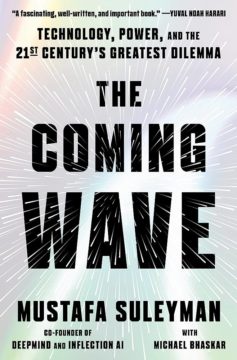Category: Recommended Reading
Why Barbenheimer Won’t Save Cinema
Ellen Peirson-Hagger at The New Statesman:
 “Barbenheimer saves cinema!” declared a Daily Mail headline in late July. The tabloid wasn’t the only publication wildly exaggerating the impact of the summer blockbuster releases Barbie and Oppenheimer: two very different works appealing to very different audiences, both released on 21 July, that social media gleefully christened under the portmanteau. Almost every outlet heralded the films as saviours of a dying industry. “Barbenheimer has saved cinema from the jaws of streaming – and not a moment too soon,” announced the i. The “Barbenheimer bonanza” insisted the Guardian, “saved the summer box office”. “Barbenheimer may just have saved London’s cinemas,” claimed Time Out.
“Barbenheimer saves cinema!” declared a Daily Mail headline in late July. The tabloid wasn’t the only publication wildly exaggerating the impact of the summer blockbuster releases Barbie and Oppenheimer: two very different works appealing to very different audiences, both released on 21 July, that social media gleefully christened under the portmanteau. Almost every outlet heralded the films as saviours of a dying industry. “Barbenheimer has saved cinema from the jaws of streaming – and not a moment too soon,” announced the i. The “Barbenheimer bonanza” insisted the Guardian, “saved the summer box office”. “Barbenheimer may just have saved London’s cinemas,” claimed Time Out.
On the surface, the box office figures showed a boom in cinema-going. As of 13 August, Greta Gerwig’s Barbie, which stars Margot Robbie and Ryan Gosling and playfully challenges ideas of the patriarchy, had taken $1.18bn at the worldwide box office. It is the highest-grossing movie in the US made by a female director. Meanwhile Oppenheimer, Christopher Nolan’s biographical thriller starring Cillian Murphy as the scientist who developed the atom bomb, has grossed $649m worldwide, making it the highest-grossing Second World War film.
more here.
Borromini – mystery man of the Baroque: Jed Perl and Deborah Rosenthal in conversation with Morgan Meis
Morgan Meis in The Easel:
 Morgan Meis: Borromini is a name probably not immediately familiar to your average reader. Can we start with a brief explanation of who he was and why his work is of interest?
Morgan Meis: Borromini is a name probably not immediately familiar to your average reader. Can we start with a brief explanation of who he was and why his work is of interest?
Jed Perl: Francesco Borromini is the mystery man of seventeenth-century Roman architecture. Both during his life and after his death – in 1667, possibly a suicide – this great architect was often overshadowed by another artist, Gian Lorenzo Bernini, who was not only a great architect but also a transcendent sculptor and a painter of consequence. Bernini’s Rome is all about grand gestures, crowds, spectacles — a place to see and be seen. He did much to shape the public face of Rome as we know it even today, through major commissions that included St. Peter’s in the Vatican and the Four Rivers Fountain in the Piazza Navona. Borromini brought other dimensions to seventeenth-century Rome – qualities of intimacy, fantasy, and interiority in buildings that include the churches of S. Carlo alle Quattro Fontane and S. Ivo della Sapienza and the Oratorio dei Filippini.
Deborah Rosenthal: Borromini, like all seventeenth-century Italian architects, used a classical vocabulary of columns, capitals, pediments, arches, and domes that dated back to ancient Greek and Roman times. But he took the stately and sometimes even static Euclidean geometry that those forms suggested to many great architects, and replaced it with a dancing, careening geometry of ovals and spirals and enigmatically torqued spaces.
More here.
The Usefulness of a Memory Guides Where the Brain Saves It
Saugat Bolakhe in Quanta:
 Memory doesn’t represent a single scientific mystery; it’s many of them. Neuroscientists and psychologists have come to recognize varied types of memory that coexist in our brain: episodic memories of past experiences, semantic memories of facts, short- and long-term memories, and more. These often have different characteristics and even seem to be located in different parts of the brain. But it’s never been clear what feature of a memory determines how or why it should be sorted in this way.
Memory doesn’t represent a single scientific mystery; it’s many of them. Neuroscientists and psychologists have come to recognize varied types of memory that coexist in our brain: episodic memories of past experiences, semantic memories of facts, short- and long-term memories, and more. These often have different characteristics and even seem to be located in different parts of the brain. But it’s never been clear what feature of a memory determines how or why it should be sorted in this way.
Now, a new theory backed by experiments using artificial neural networks proposes that the brain may be sorting memories by evaluating how likely they are to be useful as guides in the future. In particular, it suggests that many memories of predictable things, ranging from facts to useful recurring experiences — like what you regularly eat for breakfast or your walk to work — are saved in the brain’s neocortex, where they can contribute to generalizations about the world. Memories less likely to be useful — like the taste of that unique drink you had at that one party — are kept in the seahorse-shaped memory bank called the hippocampus.
More here.
“The Gardener of Lashkar Gah” by Larisa Brown — Review
John Simpson in The Guardian:
 Even people around President Biden now accept that pulling out of Afghanistan in the way the US did two years ago was an utter disaster. It ruined the lives of millions, destroyed the social and economic advances of 20 years, and returned the country’s women to a state of slavery. The result was to make the US look weak and pathetic; no wonder Vladimir Putin decided he could safely invade Ukraine, only six months later.
Even people around President Biden now accept that pulling out of Afghanistan in the way the US did two years ago was an utter disaster. It ruined the lives of millions, destroyed the social and economic advances of 20 years, and returned the country’s women to a state of slavery. The result was to make the US look weak and pathetic; no wonder Vladimir Putin decided he could safely invade Ukraine, only six months later.
The suffering of ordinary Afghans as they panicked and tried to escape the Taliban shocked the entire world. The scenes in the approaches to Kabul airport on those 17 boiling hot August days were unbearable. People tore at one another and trod the dying underfoot in order to get to the barbed wire that separated them from the airfield, screaming and waving the bits of paper they hoped would get them out of the country. The Taliban fighters lost all control, hitting out indiscriminately with their rifle butts, and firing into the air or at people’s feet. Some women tried to throw their babies over the barbed wire to the British and American soldiers on the other side; more than one baby landed on the wire itself.
More here.
RIP Douglas Lenat
Tuesday Poem
Meat Market
—after Lebanon, a country with one of the worst economic crises since the 19th century
the price of bread has gone up again. Throngs of cars
slouch toward shuttering gas stations. The currency, a farce
with each swing of the gavel, numbers
soar. Fifty thousand pounds by day’s end.
what’s another ten thousand? Or a hundred thousand?
a hundred and forty thousand pounds to the dollar
my mother’s aged laugh thunders about the
price of rice. I worry myself out of an appetite
I want to believe in miracles, instead
I starve gratitude with guilt.
how much for meat today? There are
no lambs left to sacrifice in the afterlife.
the tomatoes wilt into speckled
wax. I bury them in the mountains.
my mother’s aged laugh thunders about the price
of olive oil. I swallow glass in small gulps.
look, the crops melt into a starved earth
peppered with griefs my people speak like spells.
behold, a nation where time itself is a construct.
where every day is simultaneously 1975, 2003, and 2020.
few things are as grotesque as survival but what if
we made this life so beautiful it has no choice but to bend.
by Lara Atallah
from Split This Rock
Bugs improve nerve regeneration: fasting-induced, microbiome-derived metabolite enhances peripheral nerve regeneration
From Nature:
 In a recent study published in Nature, Serger et al. connected intermittent fasting (IF) to gut microbiome alterations and enhanced peripheral nerve regeneration following injury.1 Fasting has been purported to have neuroregenerative effects, but the underlying mechanisms remained unclear. The authors found that IF-induced elevation of IPA (a microbiome-derived metabolite) promotes neutrophil infiltration into the dorsal root ganglia (DRG), which enhances the regeneration of sciatic nerve fibers.
In a recent study published in Nature, Serger et al. connected intermittent fasting (IF) to gut microbiome alterations and enhanced peripheral nerve regeneration following injury.1 Fasting has been purported to have neuroregenerative effects, but the underlying mechanisms remained unclear. The authors found that IF-induced elevation of IPA (a microbiome-derived metabolite) promotes neutrophil infiltration into the dorsal root ganglia (DRG), which enhances the regeneration of sciatic nerve fibers.
Peripheral nerve injuries, acquired through mechanical stress to the nerve, affect more than 20 million people in the US alone, leading to an enormous social and economic burden.2 Treatment for nerve injuries involves microsurgery and despite advancements there are still major challenges that prevent a full recovery.2 The peripheral nervous system has self-regenerative properties; however, these intrinsic properties are often insufficient and complete recovery is not achieved.2 As a consequence, more than 50% of affected individuals are not satisfied with their sensory recovery, have limited motor recovery, and neuropathic pain often develops.2 Thus, the need for new therapeutic strategies to promote nerve regeneration is urgent. The regenerative effects of environmental factors like diet and calorie restriction have been previously investigated. In their recent study, Serger et al. make an elegant connection between fasting, the gut microbiome, and neuroimmune pathways, which together improve regeneration in a mouse model of nerve injury.
More here.
Researchers Dispute High-Profile Discoveries of Cancer Microbes
Carl Zimmer in The New York Times:
 Over the past few years, a flurry of studies have found that tumors harbor a remarkably rich array of bacteria, fungi and viruses. These surprising findings have led many scientists to rethink the nature of cancer. The medical possibilities were exciting: If tumors shed their distinctive microbes into the bloodstream, could they serve as an early marker of the disease? Or could antibiotics even shrink tumors? In 2019, a start-up dug into these findings to develop microbe-based tests for cancer. This year, regulators agreed to prioritize an upcoming trial of the company’s test because of its promise for saving lives. But now several research teams have cast doubt on three of the most prominent studies in the field, reporting that they were unable to reproduce the results. The purported tumor microbes, the critics said, were most likely mirages or the result of contamination.
Over the past few years, a flurry of studies have found that tumors harbor a remarkably rich array of bacteria, fungi and viruses. These surprising findings have led many scientists to rethink the nature of cancer. The medical possibilities were exciting: If tumors shed their distinctive microbes into the bloodstream, could they serve as an early marker of the disease? Or could antibiotics even shrink tumors? In 2019, a start-up dug into these findings to develop microbe-based tests for cancer. This year, regulators agreed to prioritize an upcoming trial of the company’s test because of its promise for saving lives. But now several research teams have cast doubt on three of the most prominent studies in the field, reporting that they were unable to reproduce the results. The purported tumor microbes, the critics said, were most likely mirages or the result of contamination.
“They just found stuff that wasn’t there,” said Steven Salzberg, an expert on analyzing DNA sequences at Johns Hopkins University, who published one of the recent critiques. The authors of the work defended their data and pointed to more recent studies that reached similar conclusions. The unfolding debate reveals the tension between the potentially powerful applications that may come from understanding tumor microbes, and the challenge of deciphering their true nature. Independent experts said the current controversy is an example of the growing pains of a young but promising field. Biologists have known for decades that at least some microbes play a part in cancer. The most striking example is a virus known as HPV, which causes cervical cancer by infecting cells. And certain strains of bacteria drive other cancers in organs such as the intestines and the stomach.
More here.
Sunday, September 3, 2023
Didn’t the Italians think we were all the same — greedy Americans in search of our personal paradise?
Tanya Bush in Guernica:
 Italy would be where I would whisk, mix, and knead my way into an idealized self. If I could get there, I would shed my anxious energy and compulsive need for affirmation, my nasty addiction to the cool-mint vape. I would slow down; I would journal. I would become tan and strong from simple pastas. I would eat intuitively — no more take-out burritos in the middle of the night, no more nubby cheeses scrounged from the bowels of the fridge. If I could find a way to go to Italy, I would become a real baker.
Italy would be where I would whisk, mix, and knead my way into an idealized self. If I could get there, I would shed my anxious energy and compulsive need for affirmation, my nasty addiction to the cool-mint vape. I would slow down; I would journal. I would become tan and strong from simple pastas. I would eat intuitively — no more take-out burritos in the middle of the night, no more nubby cheeses scrounged from the bowels of the fridge. If I could find a way to go to Italy, I would become a real baker.
More here.
Sticking out your tongue while doing delicate work with your hands reveals a history of evolutionary relationships
R. Douglas Fields in Quanta:
 One day, while threading a needle to sew a button, I noticed that my tongue was sticking out. The same thing happened later, as I carefully cut out a photograph. Then another day, as I perched precariously on a ladder painting the window frame of my house, there it was again!
One day, while threading a needle to sew a button, I noticed that my tongue was sticking out. The same thing happened later, as I carefully cut out a photograph. Then another day, as I perched precariously on a ladder painting the window frame of my house, there it was again!
What’s going on here? I’m not deliberately protruding my tongue when I do these things, so why does it keep making appearances? After all, it’s not as if that versatile lingual muscle has anything to do with controlling my hands. Right?
Yet as I would learn, our tongue and hand movements are intimately interrelated at an unconscious level. This peculiar interaction’s deep evolutionary roots even help explain how our brain can function without conscious effort.
More here.
A Nobel Prize–winning economist reflects on the dire consequences of libertarian economics.
Angus Deaton in the Boston Review:
 Smith was not only a great thinker but also a great writer. He was an empirical economist whose sketchy data were more often right than wrong; he was skeptical, especially about wealth; and he was a balanced and humane thinker who cared about justice, noting how much more important it was than beneficence. But the story I want to tell is about economic failure and about economics failure, and about how Smith’s insights and humanity need to be brought back into the mainstream of economics. Much of the evidence that I use draws on my work with Anne Case as well as her work with Lucy Kraftman on Scotland in relation to the rest of the UK.
Smith was not only a great thinker but also a great writer. He was an empirical economist whose sketchy data were more often right than wrong; he was skeptical, especially about wealth; and he was a balanced and humane thinker who cared about justice, noting how much more important it was than beneficence. But the story I want to tell is about economic failure and about economics failure, and about how Smith’s insights and humanity need to be brought back into the mainstream of economics. Much of the evidence that I use draws on my work with Anne Case as well as her work with Lucy Kraftman on Scotland in relation to the rest of the UK.
In her recent book Adam Smith’s America (2022), political scientist Glory Liu reports that in 1976, at an event celebrating the bicentenary of the publication of Smith’s The Wealth of Nations, George Stigler, the eminent Chicago economist, said “I bring you greetings from Adam Smith, who is alive and well and living in Chicago!” Stigler might also have noted that the U.S. economy was flourishing too, as it had been for three decades, and might have been happy to connect the flourishing of Smith and the flourishing of the economy.
More here.
‘I hope I’m wrong’: the co-founder of DeepMind on how AI threatens to reshape life as we know it
David Shariatmadari in The Guardian:
 Halfway through my interview with the co-founder of DeepMind, the most advanced AI research outfit in the world, I mention that I asked ChatGPT to come up with some questions for him. Mustafa Suleyman is mock-annoyed, because he’s currently developing his own chatbot, called Pi, and says I should have used that. But it was ChatGPT that became the poster child for the new age of artificial intelligence earlier this year, when it showed it could do everything from compose poetry about Love Island in the style of John Donne to devise an itinerary for a minibreak in Lisbon.
Halfway through my interview with the co-founder of DeepMind, the most advanced AI research outfit in the world, I mention that I asked ChatGPT to come up with some questions for him. Mustafa Suleyman is mock-annoyed, because he’s currently developing his own chatbot, called Pi, and says I should have used that. But it was ChatGPT that became the poster child for the new age of artificial intelligence earlier this year, when it showed it could do everything from compose poetry about Love Island in the style of John Donne to devise an itinerary for a minibreak in Lisbon.
The trick hadn’t really worked, or so I thought – ChatGPT’s questions were mostly generic talking points. I’d asked it to try a bit harder. “Certainly, let’s dive into more specific and original questions that can elicit surprising answers from Mustafa Suleyman,” it had trilled. The results still weren’t up to much. Even so, I chuck one at him as he sits in the offices of his startup in Palo Alto on the other end of a video call (he left DeepMind in 2019). “How do you envision AI’s role in supporting mental health care in the future,” I ask – and suddenly, weirdly, I feel as if I’ve got right to the heart of why he does what he does.
More here.
Jackie Mason Holds Nothing Back
Daniel Kahneman: Experiencing Self and Remembering Self
Tina Howe (1937 – 2023) Playwright
Nancy Buirski (1945 – 2023) Documentary Filmmaker
Jimmy Buffett (1946 – 2023) Singer
Saturday, September 2, 2023
AI Threatens To Reshape Life As We Know It
David Shariatmadari at The Guardian:
 The Coming Wave distils what is about to happen in a forcefully clear way. AI, Suleyman argues, will rapidly reduce the price of achieving any goal. Its astonishing labour-saving and problem-solving capabilities will be available cheaply and to anyone who wants to use them. He memorably calls this “the plummeting cost of power”. If the printing press allowed ordinary people to own books, and the silicon chip put a computer in every home, AI will democratise simply doing things. So, sure, that means getting a virtual assistant to set up a company for you, or using a swarm of builder bots to throw up an extension. Unfortunately, it also means engineering a run on a bank, or creating a deadly virus using a DNA synthesiser.
The Coming Wave distils what is about to happen in a forcefully clear way. AI, Suleyman argues, will rapidly reduce the price of achieving any goal. Its astonishing labour-saving and problem-solving capabilities will be available cheaply and to anyone who wants to use them. He memorably calls this “the plummeting cost of power”. If the printing press allowed ordinary people to own books, and the silicon chip put a computer in every home, AI will democratise simply doing things. So, sure, that means getting a virtual assistant to set up a company for you, or using a swarm of builder bots to throw up an extension. Unfortunately, it also means engineering a run on a bank, or creating a deadly virus using a DNA synthesiser.
The most extraordinary scenarios in the book come from the realm of biotech, which is already undergoing its own transformation thanks to breakthroughs such as Crispr, the gene-editing technology. Here, AI will act as a potent accelerant. Manufactured products, Suleyman tells us, could one day be “grown” from synthetic biological materials rather than assembled, using carbon sucked out of the atmosphere.
more here.
The Second World War, the Holocaust, and the Music of Remembrance
Kira Thurman at the New York Times:
 In 1947, the Black German musician Fasia Jansen stood on a street in Hamburg and began to sing the music of Brecht in her thick Low German accent to anyone passing by. Perhaps she’d learned the songs from prisoners and internees at Neuengamme, the concentration camp where she’d been forced to work four years earlier. Perhaps she’d learned them in the early days after the war, when she’d performed with Holocaust survivors at a hospital in 1945. One thing was clear: As Jansen wrestled with her trauma, song was at the center of her experience.
In 1947, the Black German musician Fasia Jansen stood on a street in Hamburg and began to sing the music of Brecht in her thick Low German accent to anyone passing by. Perhaps she’d learned the songs from prisoners and internees at Neuengamme, the concentration camp where she’d been forced to work four years earlier. Perhaps she’d learned them in the early days after the war, when she’d performed with Holocaust survivors at a hospital in 1945. One thing was clear: As Jansen wrestled with her trauma, song was at the center of her experience.
Jansen does not appear in Jeremy Eichler’s new book, “Time’s Echo,” but the impulse to turn to music during and after the Holocaust is at the heart of it. Eichler, The Boston Globe’s chief classical music critic, suggests that music can help us remember what we’ve lost. “Time’s Echo” is an engrossing recovery project that reveals the depths of Europe’s ability — and inability — to mourn those losses.
more here.
